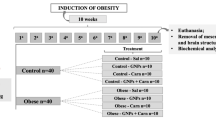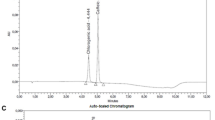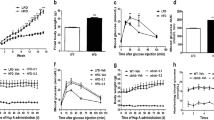Abstract
Obesity is characterized by chronic inflammation of low grade. The cholinergic anti-inflammatory pathway favors the reduction of the inflammatory response. In this work the effect of stimulation of the cholinergic anti-inflammatory pathway on SHIRPA behavioral test and mitochondrial respiratory chain activity in obese mice was evaluated. The animals were paired in four groups: saline + control diet; donepezil + control diet; saline + high-fat diet and donepezil + high-fat diet. 5 mg/kg/day orally of donepezil or saline were given 7 days before the beginning of the diet until completing 11 weeks of the experiment. Food intake and body weight were measured. At the end of the experiment the animals were submitted to the SHIRPA behavioral test, soon after they were killed by decapitation, the open abdominal cavity and the mesenteric fat were removed. The hypothalamus, hippocampus, prefrontal cortex, and striatum were removed for evaluation of the mitochondrial respiratory chain. It can be observed that donepezil prevented weight gain and food consumption, as well as a tendency to prevent the accumulation of mesenteric fat in obese animals. There was no behavioral change in obese animals, nor did the influence of donepezil on these parameters. On the other hand, donepezil did not prevent inhibition of complex I activity, prevented the inhibition of complex II, and showed a tendency to prevent IV complex activity inhibited in obesity. With these results it can be concluded that the activation of the cholinergic anti-inflammatory pathway is promising for the alterations found in obesity.








Similar content being viewed by others
References
World Health Organization (2018) Obesity and overweight. WHO. https://www.who.int/mediacentre/factsheets/fs311/en/. Accessed 12 Mar 2018
World Obesity Federation (2015) About obesity. World Obesity. https://www.worldobesity.org/about/about-obesity. Accessed 12 Mar 2018
Knight JA (2011) Diseases and disorders associated with excess body weight. Ann Clin Lab Sci 41(2):107–121
González-Muniesa P, Mártinez-González MA, Hu FB et al (2017) Obesity. Nat Rev Dis Primers 3:17034. https://doi.org/10.1038/nrdp.2017.34
Rui L (2013) Brain regulation of energy balance and body weight. Rev Endocr Metab Disord 14(4):387–407. https://doi.org/10.1007/s11154-013-9261-9
Patel PS, Buras ED, Balasubramanyam A (2013) The role of the immune system in obesity and insulin resistance. J Obes 2013:1–9. https://doi.org/10.1155/2013/616193
Vincent HK, Taylor AG (2006) Biomarkers and potential mechanisms of obesity induced oxidant stress in humans. Int J Obes 30:400–418. https://doi.org/10.1038/sj.ijo.0803177
Birben E, Sahiner UM, Sackesen C et al (2012) Oxidative stress and antioxidant defense. World Allergy Organ J 5(1):9–19. https://doi.org/10.1097/WOX.0b013e3182439613
Boekema EJ, Braun HP (2007) Supramolecular structure of the mitochondrial oxidative phosphorylation system. J Biol Chem 282(1):1–4. https://doi.org/10.1074/jbc.R600031200
Milanski M, Degasperi G, Coope A et al (2009) Saturated fatty acids produce an inflammatory response predominantly through the activation of TLR4 signaling in hypothalamus: implications for the pathogenesis of obesity. J Neurosci 29(2):359–370. https://doi.org/10.1523/JNEUROSCI.2760-08.2009
Moraes JC, Coope A, Morari J et al (2009) High-fat diet induces apoptosis of hypothalamic neurons. PLoS ONE 4(4):e5045. https://doi.org/10.1371/journal.pone.0005045
Thaler JP, Yi CX, Schur EA et al (2012) Obesity is associated with hypothalamic injury in rodents and humans. J Clin Investig 122(1):153–162. https://doi.org/10.1172/JCI59660
Velloso LA, Schwartz MW (2011) Altered hypothalamic function in diet-induced obesity. Int J Obes 35:1455–1465. https://doi.org/10.1038/ijo.2011.56
Williams LM (2012) Hypothalamic dysfunction in obesity. Proc Nutr Soc 71(4):521–533. https://doi.org/10.1017/S002966511200078X
Freeman LR, Zhang L, Nair A et al (2013) Obesity increases cerebrocortical reactive oxygen species and impairs brain function. Free Radic Biol Med 56:226–233. https://doi.org/10.1016/j.freeradbiomed.2012.08.577
de Mello AH, Schraiber RB, Goldim MPS et al (2019) Omega-3 fatty acids attenuate brain alterations in high-fat diet-induced obesity model. Mol Neurobiol 56(1):513–524. https://doi.org/10.1007/s12035-018-1097-6
Farr OM, Li CR, Mantzoros CS (2016) Central nervous system regulation of eating: insights from human brain imaging. Metabolism 65(5):699–713. https://doi.org/10.1016/j.metabol.2016.02.002
Paumgartten FJR (2011) Tratamento farmacológico da obesidade: a perspectiva da saúde pública. Cad Saúde Pública 27(3):404–405. https://doi.org/10.1590/S0102-311X2011000300001
Giacobini E (1993) Pharmacotherapy of Alzheimer disease: new drugs and novel strategies. Prog Brain Res 98:447–454. https://doi.org/10.1016/S0079-6123(08)62431-0
Francis PT, Palmer AM, Snape M et al (1999) The cholinergic hypothesis of Alzheimer’s disease: a review of progress. J Neurol Neurosurg Psychiatry 66(2):137–147. https://doi.org/10.1136/jnnp.66.2.137
Wilkinson DG (1999) The pharmacology of donepezil: a new treatment of Alzheimer's disease. Expert Opin Pharmacother 1(1):121–135. https://doi.org/10.1517/14656566.1.1.121
Hansen RA, Gartlehner G, Webb AP et al (2008) Efficacy and safety of donepezil, galantamine, and rivastigmine for the treatment of Alzheimer’s disease: a systematic review and meta-analysis. Clin Interv Aging 3(2):211–225
Takada-Takatori Y, Kume T, Ohgi Y et al (2008) Mechanism of neuroprotection by donepezila pretreatment in rat cortical neurons chronically treated with donepezil. J Neurosci Res 86(16):3575–3583. https://doi.org/10.1002/jnr.21798
Zhang X, Jiang X, Huang L et al (2018) Central cholinergic system mediates working memory deficit induced by anesthesia/surgery in adult mice. Brain Behav 8(5):e00957. https://doi.org/10.1002/brb3.957
Li YX, Ye ZH, Chen T et al (2018) The effects of donepezil on phencyclidine-induced cognitive deficits in a mouse model of schizophrenia. Pharmacol Biochem Behav 175:69–76. https://doi.org/10.1016/j.pbb.2018.09.006
Xu H, Chen L, Zhang X et al (2019) Central cholinergic neuronal degeneration promotes the development of postoperative cognitive dysfunction. Lab Invest 99(7):1078–1088. https://doi.org/10.1038/s41374-018-0174-9
Rogers DC, Fisher EMC, Brown SDM et al (1997) Behavioral and functional analysis of mouse phenotype: SHIRPA, a proposed protocol for comprehensive phenotype assessment. Mamm Genome 8(10):711–713. https://doi.org/10.1007/s003359900551
Lackner P, Beer R, Heussler V et al (2006) Behavioural and histopathological alterations in mice with cerebral malaria. Neuropathol Appl Neurobiol 32(2):177–188. https://doi.org/10.1111/j.1365-2990.2006.00706.x
Lowry OH, Rosebrough NJ, Farr AL et al (1951) Protein measurement with the folin phenol reagent. J Biol Chem 193(1):265–275
Cassina A, Radi R (1996) Differential inhibitory action of nitric oxide and peroxynitrite on mitochondrial electron transport. Arch Biochem Biophys 328(2):309–316
Fischer JC, Ruitenbeek W, Berden JA et al (1985) Differential investigation of the capacity of succinate oxidation in human skeletal muscle. Clin Chim Acta 153(1):23–36. https://doi.org/10.1016/0009-8981(85)90135-4
Rustin P, Chretien D, Bourgeron T et al (1994) Biochemical and molecular investigations in respiratory chain deficiencies. Clin Chim Acta 228(1):35–51. https://doi.org/10.1016/0009-8981(94)90055-8
Dasuri K, Zhang L, Kim SO et al (1862) (2016) Dietary and donepezil modulation of mTOR signaling and neuroinflammation in the brain. Biochim Biophys Acta 2:274–283. https://doi.org/10.1016/j.bbadis.2015.11.002
Jeremias IC, Victorino VJ, Machado JL et al (2016) The severity of cecal ligature and puncture-induced sepsis correlates with the degree of encephalopathy, but the sepsis does not lead to acute activation of spleen lymphocytes in mice. Mol Neurobiol 53(5):3389–3399. https://doi.org/10.1007/s12035-015-9290-3
Comim CM, Constantino LS, Petronilho F et al (2011) Aversive memory in sepsis survivor rats. J Neural Transm (Vienna) 118(2):213–217. https://doi.org/10.1007/s00702-010-0502-8
Itou Y, Nochi R, Kuribayashi H et al (2011) Cholinergic activation of hippocampal neural stem cells in aged dentate gyrus. Hippocampus 21(4):446–459. https://doi.org/10.1002/hipo.20761
Yu TS, Kim A, Kernie SG (2015) Donepezil rescues spatial learning and memory deficits following traumatic brain injury independent of its effects on neurogenesis. PLoS ONE 10(2):e0118793. https://doi.org/10.1371/journal.pone.0118793
Jeremias IC, Victorino VJ, Barbeiro HV et al (2016) The role of acetylcholine in the inflammatory response in animals surviving sepsis induced by cecal ligation and puncture. Mol Neurobiol 53(10):6635–6643. https://doi.org/10.1007/s12035-015-9538-y
Cook RL, O’Dwyer NJ, Donges CE et al (2017) Relationship between obesity and cognitive function in young women: the food, mood and mind study. J Obes 2017:11. https://doi.org/10.1155/2017/5923862
Treviño S, Aguilar-Alonso P, Flores Hernandez JA et al (2015) A high calorie diet causes memory loss, metabolic syndrome and oxidative stress into hippocampus and temporal cortex of rats. Synapse 69(9):421–433. https://doi.org/10.1002/syn.21832
Cai H, Cong WN, Ji S et al (2012) Metabolic dysfunction in Alzheimer’s disease and related neurodegenerative disorders. Curr Alzheimer Res 9(1):5–17. https://doi.org/10.2174/156720512799015064
Ward MA, Carlsson CM, Trivedi MA et al (2005) The effect of body mass index on global brain volume in middle-aged adults: a cross sectional study. BMC Neurol 5:23. https://doi.org/10.1186/1471-2377-5-23
Convit A (2012) Obesity is associated with structural and functional brain abnormalities: where do we go from here? Psychosom Med 74(7):673–674. https://doi.org/10.1097/PSY.0b013e3182662c56
Shefer G, Marcus Y, Stern N (2013) Is obesity a brain disease? Neurosci Biobehav Rev 37(10):2489–2503. https://doi.org/10.1016/j.neubiorev.2013.07.015
Boitard C, Cavaroc A, Sauvant J et al (2014) Impairment of hippocampal-dependent memory induced by juvenile high-fat diet intake is associated with enhanced hippocampal inflammation in rats. Brain Behav Immun 40:9–17. https://doi.org/10.1016/j.bbi.2014.03.005
Davidson TL, Hargrave SL, Swithers SE et al (2013) Inter-relationships among diet, obesity and hippocampal-dependent cognitive function. Neuroscience 253:110–122. https://doi.org/10.1016/j.neuroscience.2013.08.044
Tomasi D, Volkow ND (2013) Striatocortical pathway dysfunction in addiction and obesity: differences and similarities. Crit Rev Biochem Mol Biol 48(1):1–19. https://doi.org/10.3109/10409238.2012.735642
Nummenmaa L, Hirvonen J, Hannukainen JC et al (2012) Dorsal striatum and its limbic connectivity mediate abnormal anticipatory reward processing in obesity. PLoS ONE 7(2):e31089. https://doi.org/10.1371/journal.pone.0031089
Stice E, Yokum S, Blum K et al (2010) Weight gain is associated with reduced striatal response to palatable food. J Neurosci 30(39):13105–13109. https://doi.org/10.1523/JNEUROSCI.2105-10.2010
Heales SJR, Bolaños JP, Stewart VC et al (1999) Nitric oxide, mitochondria and neurological disease. Biochim Biophys Acta 1410(2):215–228. https://doi.org/10.1016/S0005-2728(98)00168-6
Aw TY, Jones DP (1989) Nutrient supply and mitochondrial function. Annu Rev Nutr 9:229–251. https://doi.org/10.1146/annurev.nu.09.070189.001305
Wullner U, Seyfried J, Groscurth P (1999) Glutathione depletion and neuronal cell death: the role of reactive oxygen intermediates and mitochondrial function. Brain Res 826(1):53–62. https://doi.org/10.1016/S0006-8993(99)01228-7
Hüttemann M, Lee I, Pecinova A et al (2008) Regulation of oxidative phosphorylation, the mitochondrial membrane potential, and their role in human disease. J Bioenergy Biomembr 40(5):445–456. https://doi.org/10.1007/s10863-008-9169-3
Bournat JC, Brown CW (2010) Mitochondrial dysfunction in obesity. Curr Opin Endocrinol Diabetes Obes 17(5):446–452. https://doi.org/10.1097/MED.0b013e32833c3026
Alfadda AA, Sallam RM (2012) Reactive oxygen species in health and disease. J Biomed Biotechnol 936486:1–14. https://doi.org/10.1155/2012/936486
Singh N, Hroudová J, Fišar Z (2017) In vitro effects of cognitives and nootropics on mitochondrial respiration and monoamine oxidase activity. Mol Neurobiol 54(8):5894–5904. https://doi.org/10.1007/s12035-016-0121-y
Pavlov VA, Tracey KJ (2005) The cholinergic anti-inflammatory pathway. Brain Behav Immun 19(6):493–499. https://doi.org/10.1016/j.bbi.2005.03.015
Pavlov VA, Ochani M, Gallowitsch-Puerta M et al (2006) Central muscarinic cholinergic regulation of the systemic inflammatory response during endotoxemia. Proc Natl Acad Sci USA 103(13):5219–5223. https://doi.org/10.1073/pnas.0600506103
Olofsson PS, Rosas-Ballina M, Levine YA et al (2012) Rethinking inflammation: neural circuits in the regulation of immunity. Immunol Rev 248(1):188–204. https://doi.org/10.1111/j.1600-065X.2012.01138.x
Frohnert BI, Bernlohr DA (2013) Protein carbonylation, mitochondrial dysfunction, and insulin resistance. Adv Nutr 4(2):157–163. https://doi.org/10.3945/an.112.003319
Hernández-Aguilera A, Rull A, Rodríguez-Gallego E et al (2013) Mitochondrial dysfunction: a basic mechanism in inflammation-related non-communicable diseases and therapeutic opportunities. Mediat Inflamm 2013:13. https://doi.org/10.1155/2013/135698
Funding
This research was supported by grant from Fundação de Amparo à Pesquisa e Inovação do Estado de Santa Catarina (FAPESC) 2016TR2228. The funding sources were not involved in the conduction of the research, preparation of the article nor in the decision to submit the article for publication.
Author information
Authors and Affiliations
Corresponding author
Ethics declarations
Conflict of interest
The authors declare that they have no conflicts of interest.
Ethical Approval
Certificates that the experiments were carried out in accordance with the National Guide of the Institute of Health for the Care and Use of Laboratory Animals in accordance with the protocol 17.010.2.08.IV.
Informed Consent
I hereby confirm that all authors have seen and approved the manuscript. I also confirm that the manuscript has not previously been published in journal form and it is not being considered for publication elsewhere.
Additional information
Publisher's Note
Springer Nature remains neutral with regard to jurisdictional claims in published maps and institutional affiliations.
Rights and permissions
About this article
Cite this article
de Farias, B.X., Costa, A.B., Engel, N.A. et al. Donepezil Prevents Inhibition of Cerebral Energetic Metabolism Without Altering Behavioral Parameters in Animal Model of Obesity. Neurochem Res 45, 2487–2498 (2020). https://doi.org/10.1007/s11064-020-03107-x
Received:
Revised:
Accepted:
Published:
Issue Date:
DOI: https://doi.org/10.1007/s11064-020-03107-x




